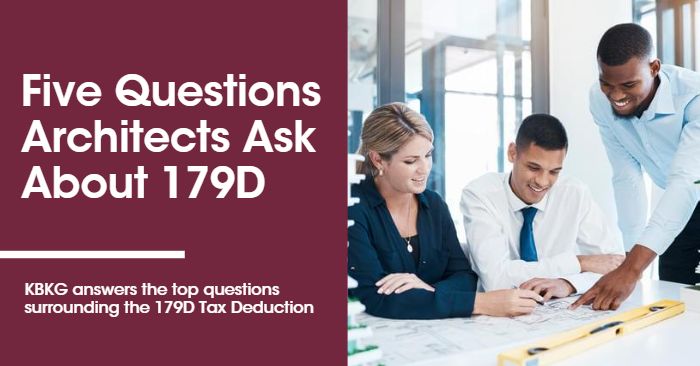Top Five Questions Designers Ask About 179D
Designers’ role in reducing the carbon footprint has left many wondering where the incentive behind designing energy-efficient buildings has come from. This recent push results from the 179D Tax Deduction, a program the U.S. government introduced as part of the Energy Policy Act (EPAct) to encourage architects to design for a more sustainable future.
While architecture and engineering firms may already be experts at designing energy-efficient buildings, they may be leaving dollars on the table if they are unfamiliar with the 179D program. To help designers of sustainable buildings better understand the Deduction and the process behind claiming it, KBKG has outlined the top five questions that are asked about 179D.
Table of Contents:
How much is the 179D Deduction worth?
For projects that occurred after December 31, 2005, candidates are eligible to claim up to $1.88 per square foot on qualifying work; however, the signing of the Inflation Reduction Act increased that number to up to $5.36 per square foot for projects completed after January 1, 2023. Eligible buildings put in place in 2024 can receive up to $5.65 per square foot.
What qualifies for an eligible improvement?
Taxpayers investing in ground-up construction or improvements to existing buildings are potentially eligible for 179D deductions. Ideal candidates have projects of more than 50,000 square feet. One of the most common ways eligible designers can qualify is by investing in and improving the following categories:
-
- Building Envelope: Designing a well-insulated building envelope using energy-efficient materials
- HVAC System: Designing energy-efficient heating and cooling systems
- Interior Lighting System: Designing lighting systems that reduce energy consumption
There are different ways to pursue the Deduction, and all require certifications by a qualified expert.
What if my project is only somewhat energy-efficient?
While there may be a concern that a building is not viewed as “energy-efficient,” results from a 179D study can surprise a building owner and its designers as standards are compared to those from 2005. KBKG conducts a preliminary review of each building to ensure it aligns with these standards to mitigate the risk of a building not qualifying for the benefits of 179D. To learn more about KBKG’s process for claiming 179D, click here.
What if my project has been allocated in the past?
Traditionally, the 179D Tax Deduction could only be allocated and claimed once throughout the life of the building. Starting in 2023, though, commercial building owners can claim 179D as often as every three years, while tax-exempt building owners, like governments or nonprofits, can allocate the Deductions to their building’s architects every four years with qualifying work.
If my building went solar, would that qualify for 179D?
Typically, solar does not qualify for 179D alone, but this improvement may impact systems that can qualify for the Deduction. Solar would only qualify if designed specifically to power HVAC equipment directly, instead of being electronically connected to the utility grid.
—
By understanding how the 179D Tax Deduction works and the kinds of improvements that qualify, architects can play a pivotal role in designing for a green future while also saving on taxes. Architects who are interested in learning more about the process for claiming this green incentive are encouraged to contact a KBKG expert today.
See If You Qualify for 179D


